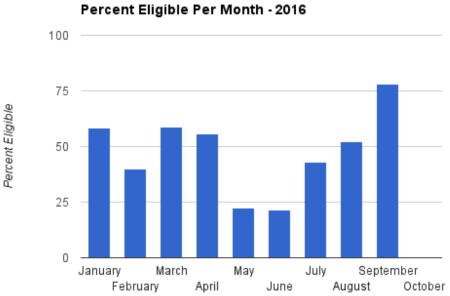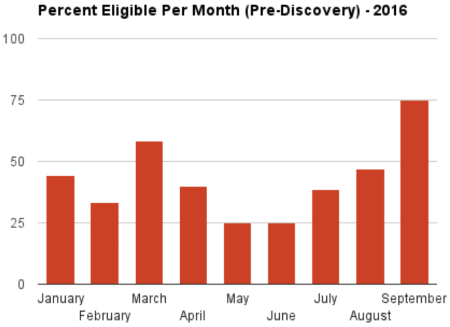
Anecdotally, there seems to be a loosening up regarding the application of § 101 by the District Courts. The 2014 Supreme Court decision in Alice Corp. v. CLS Bank Int'l has been referred to as sounding a death knell for software and business method patents, and (less hyperbolically) as a sea-change in the law of patent-eligibility. Indeed, for the first two years after Alice came down, decisions rendering challenged patents ineligible under § 101 held around 65-70% in the District Courts. Hundreds of patents and thousands of claims were invalidated.
But 2016 has brought a trio of § 101 holdings from the Federal Circuit that shored up the eligibility jurisprudence. Enfish v. Microsoft and McRo v. Bandai, as well as Bascom v. AT&T Mobility to a lesser extent, have made it abundantly clear that software can be patent-eligible if the invention is an improvement to computer technology or another technology, specifically claimed, and does not preempt any abstract ideas encompassed therein.
But have these cases had an impact on the District Courts, and if so, to what extent? While the data is still preliminary, it seems that these decisions may be making it easier for courts to find that claims are not ineligible at both the pleadings and post-discovery stages. In fact, September was the best month for patentees in all of 2016.
We collected data on every § 101 decision made in the District Courts from the beginning of the year until the end of September.[1] In total, we examined 141 distinct cases, of which claims were found eligible 73 times and ineligible 68 times, for an eligibility rate of 51.7%. Thus, it appears as if, in 2016, patents are being found eligible in a higher percentage of cases than previously.

But, as shown in the chart above, the most striking month was September, in which 78.2% (18 out of 23) of the cases came down in favor of the patentee. Not only is this the highest monthly success rate in all of 2016 (prior to September, only 46.6% of cases favored the patentee), but it dwarfs the 30-35% rate that followed Alice.
Drilling deeper, of these 23 decisions in September, 20 were decided on the pleadings, and 3 were decided after discovery. The patentee success rate for § 101 decisions made in the pleadings stage was 75% and after discovery was 100%. While patentees had a perfect record for decisions made after discovery, the significance of this observation is questionable. The after-discovery data is sparse, consisting of only 27 cases for all of 2016 so far, and in two other months patentees enjoyed 100% success as well.

The majority of the § 101 decisions in September, and throughout the year, were made on the pleadings. As shown in the chart above, the month of September was unusually good for patentees. Prior to September, the patentee success rate on the pleadings was hovering around 44%. As noted above, this increased to 75% last month. Thus, the main driver of the high rates of eligibility in September was decisions made on the pleadings.
While we cannot say with certainty why this is the case, there are likely explanations. First, the Enfish and McRo cases have made it harder for a challenger to invalidate a patent prior to discovery. Enfish made it clear that improvements to technology are patent-eligible. When reviewing a 12(b)(6) or 12(c) motion on the pleadings, the court is obliged to draw all inferences in the patentee's favor. Therefore, if the patent's specification contends that the claimed invention is a technological improvement over the prior art, this will be taken as fact for purposes of deciding the motion (of course, an unsuccessful challenger can attempt to rebut such a contention by introducing contrary evidence during discovery). In the five months since Enfish came down, it has been heavily cited by the district courts, which suggests that it is having an outsized impact on outcomes in these proceedings.
McRo, on the other hand, was decided in mid-September. Thus, it is unlikely to have had an impact on many § 101 decisions in that month. Still, in McRo the Federal Circuit clarified that that automating a process that is not known to have been performed manually can be patent-eligible. Previously, any process that could be performed manually was almost certainly ineligible. Thus, the impact of McRo is unclear but may turn out to be significant.
Second, patents being asserted post-Alice may be undergoing a higher level of vetting by their owners. As Alice wiped out swathes of patents over the last two years, patentees may be becoming more selective in which patents they assert, the result being that the patents litigated now are better equipped to withstand § 101 challenges.
Third, Post Grant Review proceedings in the USPTO may be weeding out some of the weaker patents before district court review has a chance to complete. This may include patents with claims that could be challenged under § 101 in court but are invalidated under § 102 or § 103 in an Inter Partes Review, as well as those invalidated under § 101 or other grounds in a Covered Business Method Review.
Regardless of the underlying reasons, the month of September 2016 was an outlier. Whether it is a sign of things to come remains to be seen.
[1] In this data we considered eligibility under § 101 separately from other challenges to the claims. Thus, if a claim was found eligible under § 101 but unpatentable under §§ 102 or 103, the outcome for our purposes was "eligible." Several (5) decisions were "split" in that some claims were found eligible and others were not. We omitted these cases from this analysis.